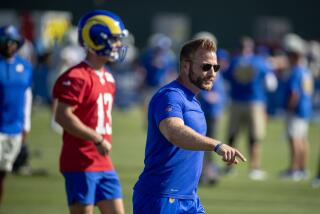Rams’ Tavon Austin can trace road to NFL to childhood competitions

It was a thin strip of grass on the median of Tioga Parkway, a bustling West Baltimore thoroughfare.
They called it the Middle Piece.
Measuring perhaps 35 yards long and 15 yards wide, the urban patch served as a makeshift football field for generations of Tavon Austin’s relatives and neighborhood kids.
It was there — with cars, trucks and buses dangerously rumbling past on both sides — that the diminutive Austin began to develop the moves, vision and will to become a first-round NFL draft pick for the Rams.
Sometimes cousins and boys older than Austin chose up sides for games. They played against each other and other neighborhoods.
But often, the game of choice was “throw-up tackle.” The ball was tossed into the air, and whoever caught it tried to maneuver through every other player on the field to reach the tree that served as the goal line.
“You got to make everybody miss,” Austin said, grinning broadly at the memory, “so that was one of my favorite games ever.”
Austin, 26, has not had many opportunities this season to showcase his moves.
After playing mainly as a receiver and punt returner during his first four NFL seasons — and signing a four-year, $42-million extension in August 2016 — the 5-foot-8, 179-pound Austin has been deployed mainly as a backup running back and decoy by first-year coach Sean McVay.
Austin, who will be paid about $15 million this season, has caught only seven passes for 43 yards, and has rushed for 171 yards and a touchdown in 36 carries. He was relieved of punt-return responsibilities after muffing several kicks early in the season.
In the Rams’ loss at Minnesota last week, Austin was on the field for only two plays. McVay blamed himself, attributing Austin’s near non-existent participation to his play-calling and the flow of the game rather than a commentary on Austin’s capability.
Austin’s role is expected to expand Sunday when the Rams play the New Orleans Saints at the Coliseum.
Robert Woods, the Rams’ top receiver, suffered a shoulder injury against the Vikings and will be sidelined this week.
Others must step up to fill the void.
Austin, described often by McVay as “a special player,” could be one of them.
“He’s definitely going to be utilized in this game,” McVay said. “He’s a part of the game plan and it will be a variety of ways.”
Austin, the eighth pick in the 2013 NFL draft, has taken his reduced role in stride. At least publicly.
He addresses his situation, and most any topic, with a quiet and intense earnestness that is as much a trademark as his speed.
“Just ready to do my part,” he said, “whenever my name gets called.”
Austin, the oldest of Cathy Green’s four children, has a history of dogged determination and preparation that dates to his childhood.
Despite his smallish stature, he was fixated on one goal.
“He never let anybody forget,” his mother said during Rams training camp in 2016. “He’d always say, “I’m going to the NFL. Did you forget? I’m going to the NFL.’ ”
Austin’s dream was nurtured by older cousins, Aaron Thompson and Shawn Waller.
Thompson was a star high school running back in Baltimore who went on to play linebacker in college at Maryland.
Austin religiously tagged along as Thompson, 12 years older, conditioned himself by running a hill outside his grandmother’s house.
“I was always training behind him,” Austin said, “and it stuck with me.”
Austin asserted his independence and also worked on his moves during his commute to school.
In elementary school, he caught the bus, transferred to the subway and then walked to campus. Growing up in a tough area, and his experiences throughout his life riding public transportation, he said, shaped him.
“You’ve got to maneuver,” he said. “You’ve got to always be on point. You’ve got to be on time, so I already had this discipline thing in me.
“I knew where I wanted to go and nobody was stopping me.”
By the time Austin was in middle school, he was working out almost daily with Waller for 11 months a year.
Waller had played basketball in college and coached youth sports teams. He put Austin and his friends through hill workouts. He also devised regimens in the small basement of his mother’s home, which affectionately became known as the Dome.
There, the boys would lift weights, hit a punching bag, perform calisthenics and agility drills and hang out and play video games.
“There would be eight, nine, 10 kids in there,” said Waller, 37. “When I look back, it wasn’t much. But it was the best we had.”
They also had the Middle Piece, where Austin held his own against older and much bigger boys.
“You have to survive in that environment,” Waller said. “He couldn’t overpower anybody. He had to outrun you or make you miss.”
The Middle Piece, located just outside Austin’s grandmother’s front door, was one of several fields within a mile radius. The “House of Pain” was a fenced patch of land near an abandoned building. “Soldier Field” was next to a brick wall and a cab company.
“None of them were perfect at all,” said Thompson, 39, “but as kids you make do. You somehow find a way to survive the elements, and that’s how it goes.”
By the time Austin arrived at Dunbar High, he was regarded as a two-sport standout, a point guard in basketball and a hybrid receiver and running back in football.
“Even in ninth grade, he had a focus on what he wanted to do and where he wanted football to take him,” said Travis Blackston, Dunbar’s offensive coordinator at the time.
In his first football game, Austin took a handoff on a jet sweep and scored on a 60-yard run with less than 15 seconds left to send the game into overtime.
He rushed for more than 1,000 yards as a freshman and 2,000 yards in each of the next three seasons. He finished with nearly 8,000 yards rushing and 123 touchdowns, Maryland state records that still stand.
If former North Carolina coach Butch Davis had told Austin he could be a running back rather than a receiver, Austin would have become a Tar Heel. Instead, he signed with West Virginia, which told him he could play running back, and then almost immediately switched him to receiver.
Austin starred for the Mountaineers, catching 29 touchdown passes, rushing for six touchdowns and returning five kicks for touchdowns.
The Rams took him with the No. 8 pick, enabling Austin to fulfill a lifelong dream.
“To see it come true after hearing him say it a thousand times growing up was one of most memorable moments of my life,” his mother said.
Austin averaged 41 receptions and caught nine touchdown passes during three seasons for the St. Louis Rams. He also rushed for seven touchdowns.
Last season, after the Rams returned to Los Angeles, he caught a career-best 58 passes, three for touchdowns, and rushed for a touchdown.
Austin was the only starting receiver retained after the Rams hired McVay to replace the fired Jeff Fisher.
When the Rams signed Woods in the offseason, Austin was regarded as a candidate to become a deep-ball threat. But Austin was sidelined for offseason workouts while recovering from wrist surgery. He suffered a hamstring injury early in training camp.
The Rams then traded for receiver Sammy Watkins, putting Austin in limbo.
Austin has played as a change-of-pace back behind Todd Gurley — he scored on a 27-yard run against Seattle in Week 4 — and has also carried the ball on jet sweeps.
With his salary-cap number dropping to about $8 million next season, Austin’s future with the Rams will no doubt be a topic of offseason discussion and speculation.
For now, Austin is focused on Sunday and an opportunity potentially awaiting against the Saints.
“There’s only one ball,” he said, “I ain’t a selfish person at all.
“Whenever my name gets called, hopefully I’ll pop a big one.”
Follow Gary Klein on Twitter @latimesklein
More to Read
Go beyond the scoreboard
Get the latest on L.A.'s teams in the daily Sports Report newsletter.
You may occasionally receive promotional content from the Los Angeles Times.








